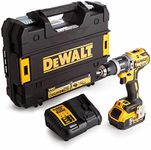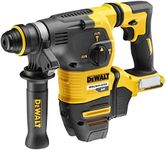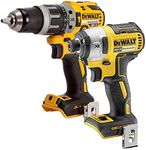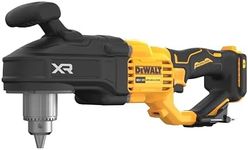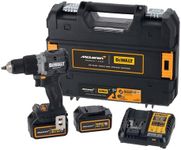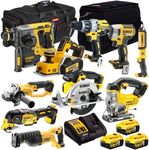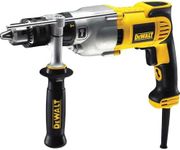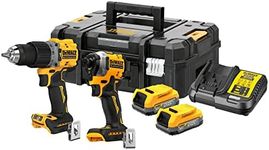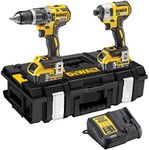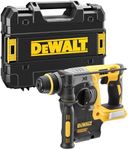Buying Guide for the Best DeWalt Drills
When choosing a DeWalt drill, it's important to consider your specific needs and the types of projects you'll be working on. DeWalt offers a range of drills with various features and capabilities, so understanding the key specifications will help you make an informed decision. Here are the main specs to consider and how to choose the best fit for you.Power SourceThe power source of a drill can be either corded or cordless. Corded drills are typically more powerful and can run indefinitely as long as they are plugged in, making them ideal for heavy-duty tasks. Cordless drills offer more convenience and portability, as they run on rechargeable batteries. If you need a drill for light to medium tasks and value mobility, a cordless drill is a great choice. For more demanding jobs, a corded drill might be more suitable.
Battery VoltageFor cordless drills, battery voltage is a key spec that indicates the power of the drill. Common voltages include 12V, 18V, and 20V. Lower voltage drills (12V) are lighter and suitable for light-duty tasks like assembling furniture. Mid-range voltage drills (18V) offer a good balance of power and weight, making them versatile for a variety of tasks. Higher voltage drills (20V) provide more power for heavy-duty tasks like drilling into masonry or metal. Choose the voltage based on the intensity of the tasks you plan to perform.
Chuck SizeThe chuck size determines the maximum diameter of the drill bit that the drill can accommodate. Common sizes are 3/8 inch and 1/2 inch. A 3/8 inch chuck is suitable for most household tasks and light to medium-duty work. A 1/2 inch chuck is better for heavy-duty tasks and can handle larger drill bits. Consider the types of projects you'll be working on and choose a chuck size that matches the drill bit sizes you'll need.
Speed SettingsDrills can have single or multiple speed settings. Single-speed drills are simpler and usually sufficient for basic tasks. Multi-speed drills offer more versatility, allowing you to adjust the speed for different materials and tasks. For example, lower speeds are better for driving screws, while higher speeds are ideal for drilling holes. If you plan to use the drill for a variety of tasks, a model with multiple speed settings will provide more flexibility.
TorqueTorque is the rotational force that the drill can apply. Higher torque is important for driving screws into tough materials and for heavy-duty drilling. Drills with adjustable torque settings allow you to control the amount of force applied, which is useful for preventing overdriving screws or damaging materials. If you need a drill for heavy-duty tasks or working with hard materials, look for a model with high torque and adjustable settings.
Weight and ErgonomicsThe weight and ergonomics of a drill affect how comfortable it is to use, especially for extended periods. Lighter drills are easier to handle and reduce fatigue, making them ideal for overhead or prolonged use. Ergonomic designs with comfortable grips and balanced weight distribution can also enhance usability. Consider how long you'll be using the drill and choose a model that feels comfortable and manageable for you.
Additional FeaturesSome drills come with additional features like built-in LED lights, belt clips, and carrying cases. LED lights can be helpful for working in low-light conditions, while belt clips and carrying cases add convenience for storage and transport. Think about which additional features might be useful for your specific needs and look for models that include them.
